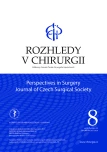Pilonidal sinus disease: Karydakis flap procedure in our patients
Authors:
M. Bubenová; D. Konečná; Z. Kala
Authors‘ workplace:
Chirurgická klinika, Masarykova univerzita, Fakultní nemocnice Brno
Published in:
Rozhl. Chir., 2020, roč. 99, č. 8, s. 350-355.
Category:
Original articles
doi:
https://doi.org/10.33699/PIS.2020.99.8.350–355
Overview
Introduction: Despite the available guidelines, opinions of many surgeons are quite ambiguous when it comes to the therapy of pilonidal sinus disease. The treatment can be a frustrating problem both for the surgeon and the patient because it is associated with wound complications and high recurrence rate. The objective of this study was to analyze the results of patients with pilonidal sinus disease undergoing the Karydakis flap procedure.
Methods: A total of 27 patients treated for primary and recurrent pilonidal disease using the Karydakis flap procedure at our department between October 23, 2018 and November 22, 2019 were analyzed prospectively. We evaluated postoperative wound healing, complications and recurrence of the disease in a short-term follow-up period. Disease recurrence was defined as prolonged healing or as a new disease requiring repeated surgery.
Results: In December 2019 all 27 patients came for a follow-up visit. The result was a fully lateralized wound without any signs of a new disease in all patients. In May 2020 a follow-up visit by phone was performed. The median follow-up was 12 months. The healing process was free of any serious complications in 25 patients. Seroma formation cases were managed by puncture in the outpatient setting.
Conclusion: According to the available evidence and guidelines, off-midline procedures – the Karydakis flap, Bascom cleft lift, and Limberg flap procedures – are associated with lower recurrence rates and better wound healing. An important goal is to achieve complete wound lateralization and to change the configuration of the gluteal cleft by reshaping it, which results in a nicely flattened gluteal crease.
Keywords:
pilonidal sinus disease – Karydakis flap procedure – Wound healing
Sources
- Bascom J. Pilonidal disease: Origin from the follicles of hairs and results of follicle removal as a treatment. Surgery 1980;87:567−572. doi:10.1016/S0022-3468(81)80139-X.
- Karydakis GE. New approach to the problem of pilonidal sinus. Lancet 1973;(2):1414−1415. doi:10.1016/s0140-6736(73)92803-1.
- Doll D, Bosche F, Hauser A, et al. The presence of occipital hair in the pilonidal sinus cavity-a triple approach to proof. Int J Colorectal Dis. 2018;33(5):567−576. doi:10.1007/s00384-018-2988-8.
- Bascom J, Bascom T. Failed pilonidal surgery. Arch Surg. 2002;137(10):1146−1150. doi:10.1001/archsurg.137.10.1146.
- Al-Khamis A, McCallum I, King PM, at al. Healing by primary versus secondary intention after surgical treatment for pilonidal disease. Cochrane Database Syst Rev. 2010;CD006213. doi:10.1002/14651858.CD006213.pub3.
- Bascom J, Bascom T. Utility of the cleft lift procedure in refractory pilonidal disease. Am J Surg. 2007;193:606−609. doi: 10.1016/j.amjsurg.2007.01.008.
- Immerman CS. Treatment of pilonidal disease using Bascom Cleft Lift procedure. AM Surgeon 2014;80(2):49:508.
- Prassas D, Rolfs TM, Schumacher FJ, et al. Karydakis flap reconstruction versus Limberg flap transposition for pilonidal sinus disease: A meta-analysis of randomised controlled trials. Langenbecks Arch Surg. 2018;403(5):547−554. doi:10.1007/s00423-018-1697-7.
- Stauffer VK, Luedi MM, Kauf P, et al. Common surgical procedures in pilonidal sinus disease:A meta-analysis, merged data analysis, and comprehensive study on recurrence. Sci Rep. 2018;8(1):3058. doi:10.1038/s41598-018-20143-4.
- Kaplan M, Ozcan O, Bilgic E, et al. Distal scar-to-midline distance in pilonidal Limberg flap surgery is a recurrence promoting factor: A multicenter case-control study. Am J Surg. 2017;214(5):811−819. doi:10.1016/j.amjsurg.2017.02.008.
- Mentes BB, Leventoglu S, Cihan A, et al. Modified Limberg transposition flap for sacrococcygeal pilonidal sinus. Surg Today 2004;34(5):419−423. doi:10.1007/s00595-003-2725-x.
- Iesalnieks I, Ommer A, Petersen S, et al. German national guideline on management of pilonidal disease. Langenbecks Arch Surg. 2016;401:599−609. doi:10.1007/s00423-016-1463−1467.
- Iesalnieks I, Deimel S, Schlitt HJ. Pit-Picking-Operation bei Patienten mit Sinus pilonidalis. Chirurg 2015; 86:482−485.
- Ypsilantis E, Carapeti E, Chan S. The use of topical 10% Metronidazole in the treatment of non-healing pilonidal sinus wounds after surgery. Int J Colorectal Dis. 2015;31(3):765−767. doi:10.1007/s00384-015-2269-8.
- Örhalmi J, Sotona O, Dušek T, et al. Pilonidální sinus-možnosti operačního řešení. Rozhl Chir. 2014;93:490−494.
- Anjum MN. Karydakis flap in the management of pilonidal sinus disease: 15 years single author experience. PSD Conference Berlin 2017.
- Kitchen PRB. Pilonidal sinus: experience with the Karydakis flap. Br J Surg. 1996;83:1452−1455. doi:10.1002/bjs.1800831040.
- Iesalnieks I, Deimel S, Schlitt HJ. Karydakis flap for recurrent pilonidal disease. World J Surg. 2013;37:1115−1120. doi:10.1007/s00268-013-1950-8.
Labels
Surgery Orthopaedics Trauma surgeryArticle was published in
Perspectives in Surgery

2020 Issue 8
Most read in this issue
- Pilonidal sinus disease: Karydakis flap procedure in our patients
- Surgical treatment of fractures of the distal radius – ORIF vs external fixation with ligamentotaxis
- Thyroid tumors at the limit of operability
- How to proceed with a patent popliteal artery aneurysm below the chronic superficial femoral artery occlusion?
